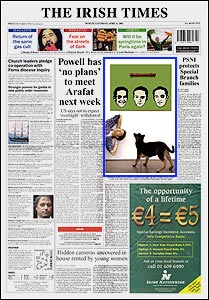| The Sunday Times, April 14, 2002.
In the artist's largest show to date, Regan explores the idea of parades. Accordingly, there is a carnivalesque quality to the works, which are mainly large-scale brightly coloured paintings, although there are a few sculptures. Regan also considers the military parade, in a series of works that feature soldiers' heads. The use of camouflage to partially obscure the subject in these paintings evokes Andy Warhol, as does the celebration of pop culture icons such as Patrick Duffy, or the Oompa Loompas from Willy Wonka and the Chocolate Factory. Consistently playful and ironic, with a strong streak of kitch, the works revel in their surface values, resisting any attempt by the viewer to interpret the subject. Catherine Daly |
||||||||||||||||
|
|
||||||||||||||||
|
The Irish Times: April 17th, 2002.
Visions of a Virtual World In a series of paintings in his exhibition Parade at 5th @ Guinness Storehouse, Paul Regan generates a sense of a virtual world that is, he implies, more real than our notionally real world. It is real because it reflects our experience of a heady, promiscuous mixture of phenomena: torrents of pop culture imagery from advertising and television programmes blend with the mundane facts of daily life, with elements of emotional routine or political conflict, say, to produce a heightened, slightly hallucinogenic environment. Regan's paintings resemble photographic drop-outs - that is, high-contrast, simplified images with the emphasis on graphic rather than photo. The flat, impassive surfaces and stylisation recall the English artist Gary Hume's glossy work. But Regan's busier, reference-packed compositions are more pop. He evidently enjoys concocting humorous narrative snippets and Monty Pythonesque, surreal juxtapositions. There are hints that he had in mind a more coherent overall project parodying the structure of an advertising campaign or a popular fiction (which would have been a good idea) but has ended up with something more diverse. He aims for a cool, knowing irony and, most though not all of the time, hits it. Aidan Dunne |
||||||||||||||||
 |
||||||||||||||||
|
Front page of The Irish Times: April 6th 2002. Click on the photo to enlarge. Exhibtion photograph by Matt Kavanagh.
|
||||||||||||||||
|
|
||||||||||||||||
| D-Side Magazine, April, 2002
Bobby Lives! We just can't get enough of artist Paul Regan right now. His bold colours, wobbly black outlines and pop subjects strike a chord in our ironic, post modern lives. What's more, his work is to urban contempory living what chunky Kit-Kats are to appetite suppressing. There's an easily identifiable nod to our processed pop culture in every piece currently on exhibit at the 5th gallery at Guinness Storehouse. Entitled Parade, featured subjects include things like Willy Wonka's Oompa Loompas to various images of Patrick Duffy, a.k.a. Bobby Ewing and The Man from Atlantis. With this show, Regan, a graduate of COMAD, has amassed his largest body of work yet. It's thoughtful; it's eclectic, and you must catch it at the Guinness Storehouse before May 19. Trust us. |
||||||||||||||||
|
|
||||||||||||||||
| Galway Advertiser, June 6, 2002
[ents] feature All Eyes on Me Pop art is alive and well in the work of Paul Regan, whose latest solo exhibition Parade is currently on at the Galway Arts Centre. The thirty-three works on show are mostly painted in emulsion and acrylic creating bold, heavily outlined images that resemble more the effect of a lino cut or a photo negative than traditional paintings. The works are presented as posters, advertisements, film stills, and cartoons. The most striking feature of the exhibition is Regan's interest in eyes. He uses teddy bear eyes on many of the faces he portrays or else he bores holes in the canvas where the eyes should have been. Such hollowed out eyes can be seen in Cyclops Cowboy, Holy Eyes, which is drawn in the style of a newspaper cartoon. Typically for such a referential form like pop art, rhinestone is also used for the cowboy's earrings. However, this is probably not what Glen Campbell meant when he sang about "Rhinestone Cowboy". While some of the works can seem ambiguous, or even vacuous, one piece that speaks volumes is "Fixing it... with a Stick". Like the other works, this large piece is painted in bold, basic colours. It shows a baseball player, in a traditional pose of waiting to hit the ball, his bat held behind his head. Above him is the legend "Fix it... with a Stick". However, it's unlikely he's actually standing in Yankee Stadium. The man's face is blacked out except for two large teddy bear eyes, and his mouth, which is open in the shape of a happy surprise. That's not the shade from his peaked cap though, it's really a balaclava. His green hat and orange shirt means he's more likely to be a member of the UVF or the IRA than the New York Yankees. On his hat there is a badge with the explosive warning symbol and a slogan saying "Stick Together". In other words, don't step out of line or else he'll fix you with a punishment beating. On the other hand, there are works of charm and gentleness like "Butterfly Girl". Here, a young Japanese girl smiles at us against a bright orange background. Around her float three large ornamental butterflies. Happiness in nature and happiness in humanity. Parade runs until Saturday June 15 and look out for a friend of Willy Wonka's when you are there. Kernan Andrews. |
||||||||||||||||
|
|
||||||||||||||||